- Eco-Strategies for Small Farms
- Posts
- The Soil Microbiome Revolution: Your Farm's Invisible Workforce
The Soil Microbiome Revolution: Your Farm's Invisible Workforce
Eco-Farm Strategies: Issue 03
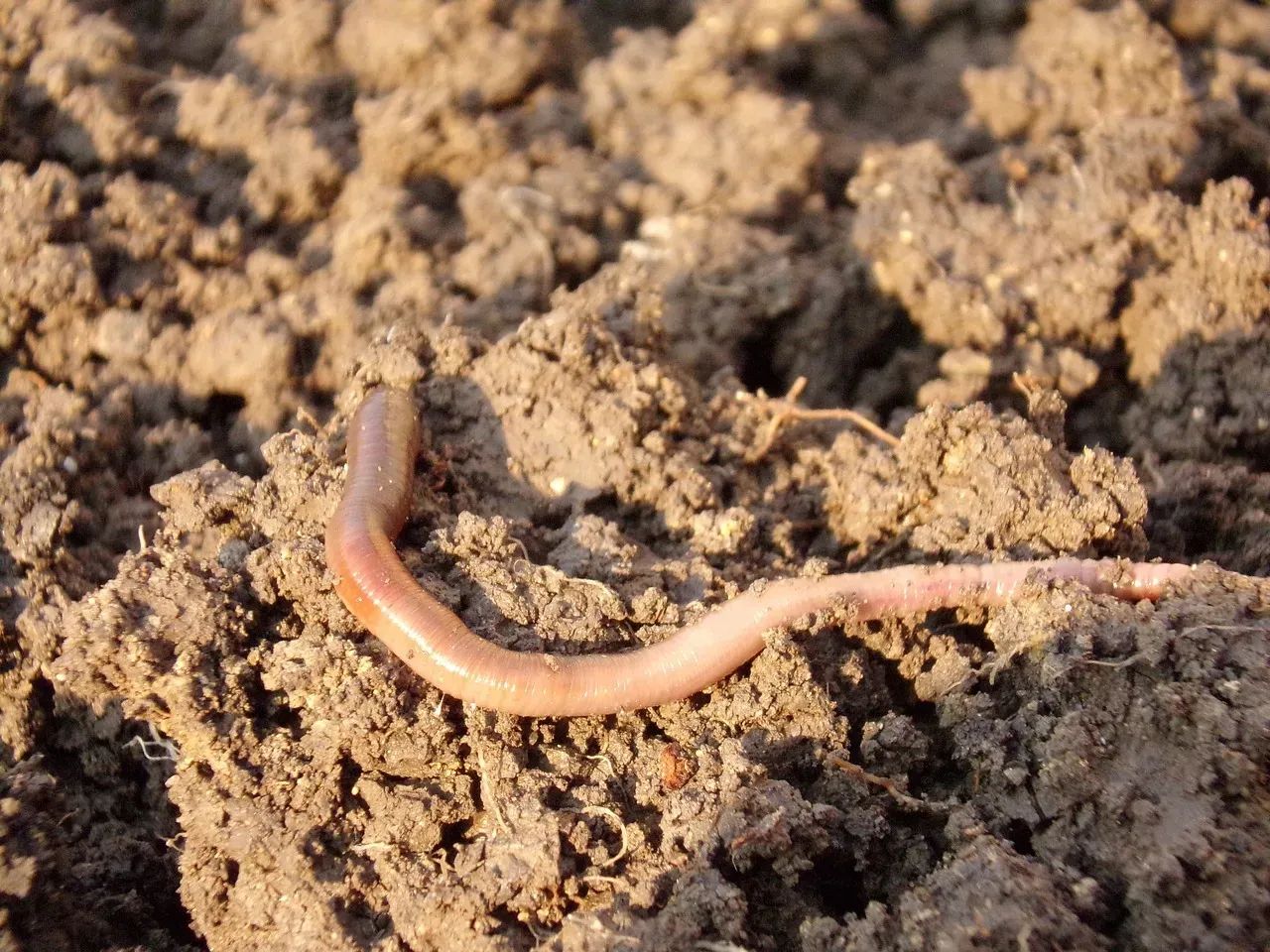
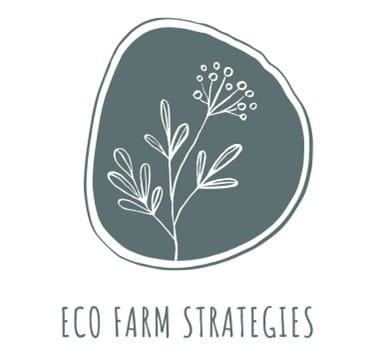
"Nature will bear the closest inspection. She invites us to lay our eye level with her smallest leaf, and take an insect view of its plain."
~Henry David Thoreau
BEST LINKS
🌿 RECOMMENDED READING
U.S. FOOD SYSTEM AT A TURNING POINT
The U.S. food system has shifted from trade surpluses to deficits while importing over half of its fresh produce, even as it overproduces corn and soy that face shrinking export markets due to chemical residue concerns. This article calls for policy reforms shifting focus from commodity surpluses to soil health, regenerative practices, and diversified food production.
🗝️ FUNDING RESOURCE 🗝️
 | AFT provides accessible grants to farmers and ranchers facing economic and environmental challenges. These grants help protect farmland, promote sustainable practices, and address societal issues like climate resilience and food system equity. |
DEEP DIVE
The Soil Microbiome Revolution: Your Farm's Invisible Workforce
How billions of microorganisms beneath your feet are transforming agriculture
The cricket song was deafening as I walked the length of the field, dogs roving ahead, snuffling their way across the pasture and back again. A thick cloud of flying insects hung suspended above the thatch of grasses, forbs and wildflowers, and my heart swelled. While some might find the sight abhorrent—to this humble farmer it is a thing of beauty, and I revel in its magnificence.
But as I knelt to examine the rich, dark soil beneath my boots, I realized the real magic wasn't happening above ground. Beneath my fingertips lay one of Earth's most complex ecosystems—a thriving metropolis of billions of microorganisms working 24/7 to create the foundation of all terrestrial life.
From "Bugs Are Yucky" to Soil Revolution
It's ironic to think I was once just as disgusted and fearful of "bugs" as the next person. Yet my journey into farming has brought about a complete transformation in my mindset. I've come to understand the interconnectedness of life on our planet—and nowhere is this more evident than in the soil beneath our feet.
We truly owe our existence to a six-inch layer of topsoil. And that revolutionary truth is changing how farmers like me approach agriculture.
For too long, we've treated soil as nothing more than dirt—an inert growing medium to hold plants upright while we dump synthetic inputs on top. This outdated mindset has cost us dearly: depleted soils, diminished yields, and farming systems dependent on ever-increasing chemical inputs.
But here's what blew my mind when I first learned about soil biology: a single teaspoon of healthy soil contains more living organisms than there are people on Earth. We're talking about 1 billion bacteria, several miles of fungal threads, 100,000 protozoa, and thousands of beneficial nematodes—all in just one teaspoon.
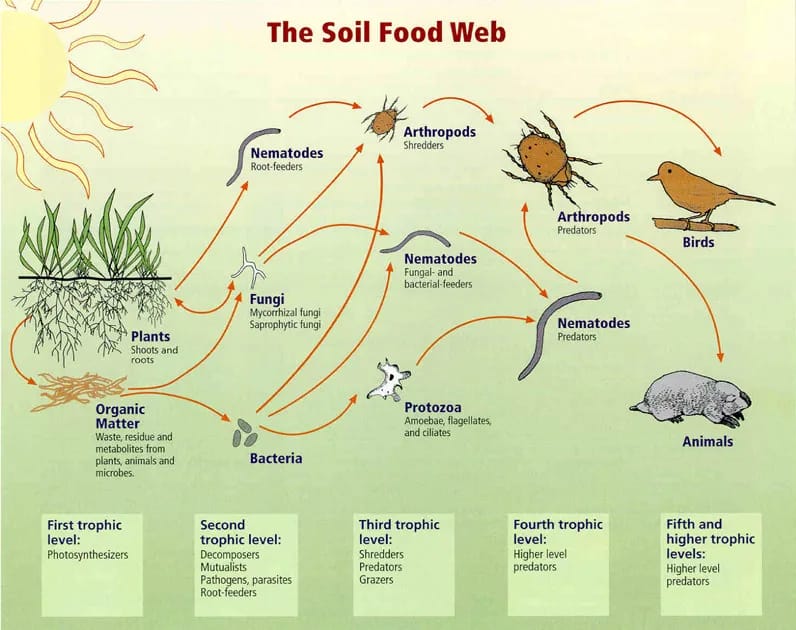
The Soil Food Web: Nature's Original Internet
At the heart of this underground ecosystem lies what scientists call the soil food web—nature's original internet, where information, nutrients, and resources flow freely between participants. As I learned more about this system, I began to see my farm not as a production facility, but as a living community.
Here's the beautiful dance happening beneath every step I take across my pasture: Plant roots release 30-40% of the sugars they produce through photosynthesis directly into the soil.
This isn't waste—it's intentional investment. Plants are essentially "farming" their own microbial communities, just like I'm farming my sheep.
The bacteria and fungi form the foundation of this network.
Bacteria excel at making nutrients available to plants, while fungi create extensive transportation networks through their thread-like hyphae. A single fungal network can extend for miles, connecting multiple plants and facilitating resource sharing—just like the community networks we farmers rely on.
What I Discovered by Working WITH the Soil
When I started implementing rotational grazing with my Finnsheep at Runamuk Acres, I unknowingly began partnering with this invisible workforce. Where once the grasses were sparse and limited in species, now exists a healthy thatch of forbs with diversity that increases annually. The field feeds not only our sheep, but numerous bird species, including bluebirds, wild turkeys, eagles and hawks.
The difference wasn't just visible above ground—it was happening in the soil, too. By reducing tillage, using cover crops, and implementing rotational grazing, I was creating conditions that allowed soil biology to thrive. These living soils with active microbial communities:
Store 20-30% more water, improving drought resilience
Cycle nutrients more efficiently, often eliminating the need for synthetic fertilizers
Suppress soil-borne diseases naturally, reducing pesticide dependency
Build stable soil structure, preventing erosion
Sequester carbon while improving fertility
The Rhizosphere: Where Magic Meets Science
The most active zone in this living system is the rhizosphere—the narrow region around plant roots where soil biology is most intense. Here, something remarkable happens that still gives me chills: plants actively recruit beneficial microorganisms by releasing specific compounds from their roots.
In return, these microbial partners provide services no synthetic input can match. They suppress harmful pathogens, produce plant growth hormones, improve stress tolerance, and create nutrient exchange networks between plants. Mycorrhizal fungi extend plant root systems by up to 1,000 times their original reach, creating communication highways that allow plants to share resources and even warning signals about threats.
Walking through my field, I'm witnessing 400 million years of biological innovation at work.
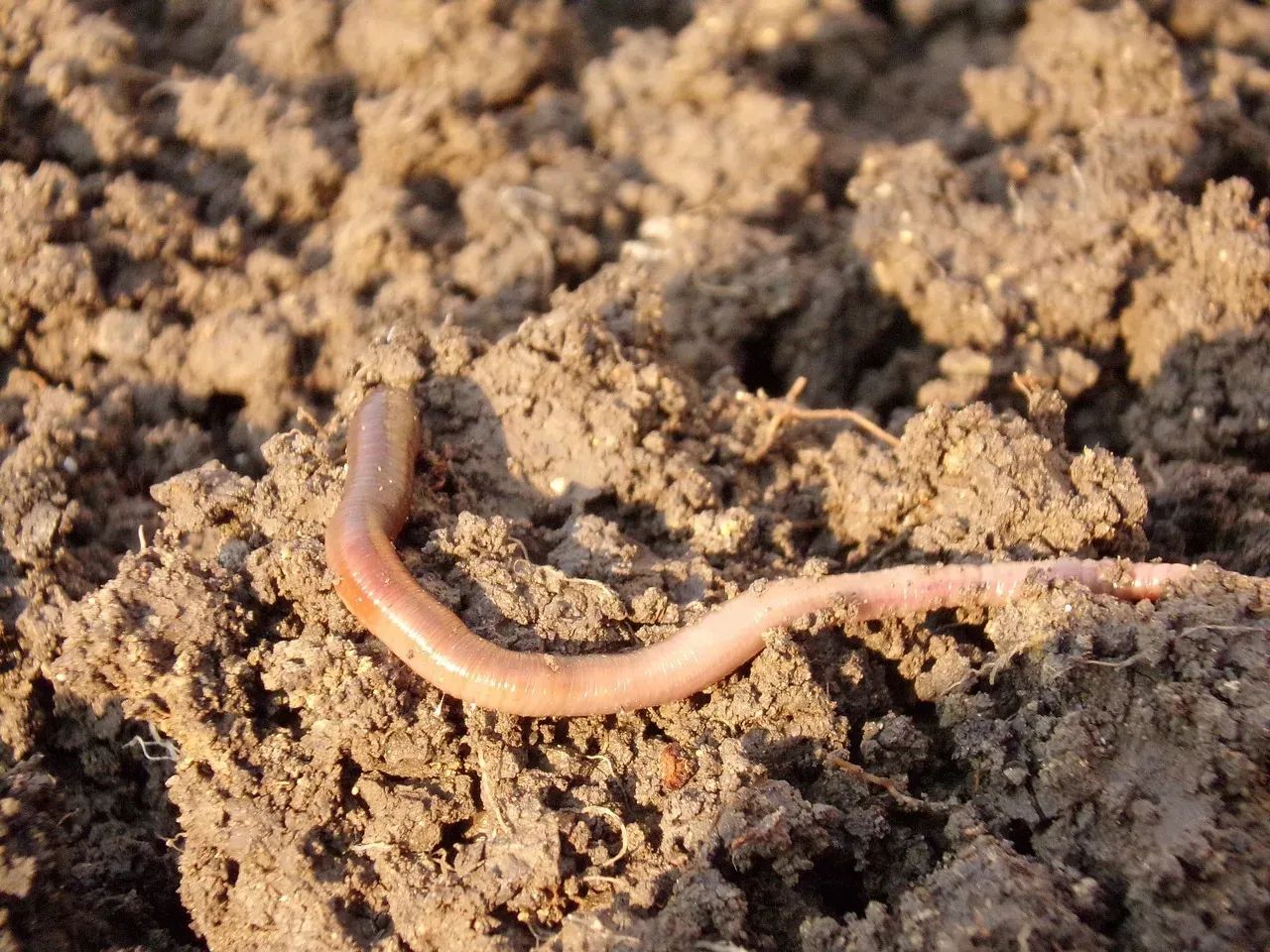
Changing Our Mindset Changes Everything
Only when we change our mindset about "the Littles"—about bugs and bacteria, fungi and microscopic arthropods—can we hope to reduce the ongoing loss of biodiversity and topsoil we're experiencing on Earth.
Your body is a walking, talking sack of microbes all working together to keep you alive and well. Our farms can work the same way—like a honeybee colony where everyone works for the good of the whole.
Understanding soil as a living system fundamentally changes how we approach farming. Instead of viewing our role as applying inputs to passive dirt, we become stewards of complex biological communities. When we feed soil biology rather than just plants, we create self-sustaining systems that become more productive and resilient over time.
Your Invisible Workforce Awaits
The soil microbiome represents the most sophisticated agricultural technology on Earth—and it's already present on your farm. The question isn't whether these biological systems work (they've been perfecting their craft for 400 million years), but whether we're creating conditions that allow them to thrive.
Every management decision on your farm either supports or undermines this invisible workforce. At Runamuk Acres, I've learned that sometimes doing less is the key to doing more. Reduced chemical inputs, diverse plantings, and rotational grazing have unleashed the biological potential that was there all along.
The revolution in agriculture isn't coming from a laboratory or chemical plant. It's happening right beneath your feet, one teaspoon of living soil at a time. And when you learn to partner with it rather than fight against it, you'll discover what I have: that the most profound changes often come from working with nature instead of against it.
The cricket songs in my fields aren't just beautiful—they're the soundtrack of a living system in perfect harmony. And beneath it all, billions of invisible workers are building the foundation for a more sustainable agricultural future.
RECOMMENDATIONS
🪜 Your Action Step This Week:
Stop or reduce tillage on a test section of your farm.
Tillage destroys the fungal networks and microbial communities that create nature's underground "internet," so simply not disturbing the soil allows billions of microorganisms to immediately begin rebuilding their life-sustaining networks.
🔮 WHAT’S COMING NEXT?
Ready to learn more about harnessing your soil's biological potential? Next week, we'll reveal the science behind why ecological practices consistently outperform conventional methods—and how you can start implementing them on your farm.
🔦 COMMUNITY SPOTLIGHT 🔦
Ray Archuleta, known as "The Soil Guy," is a certified professional soil scientist who spent over 30 years with the USDA's Natural Resources Conservation Service before becoming one of the most influential voices in regenerative agriculture.
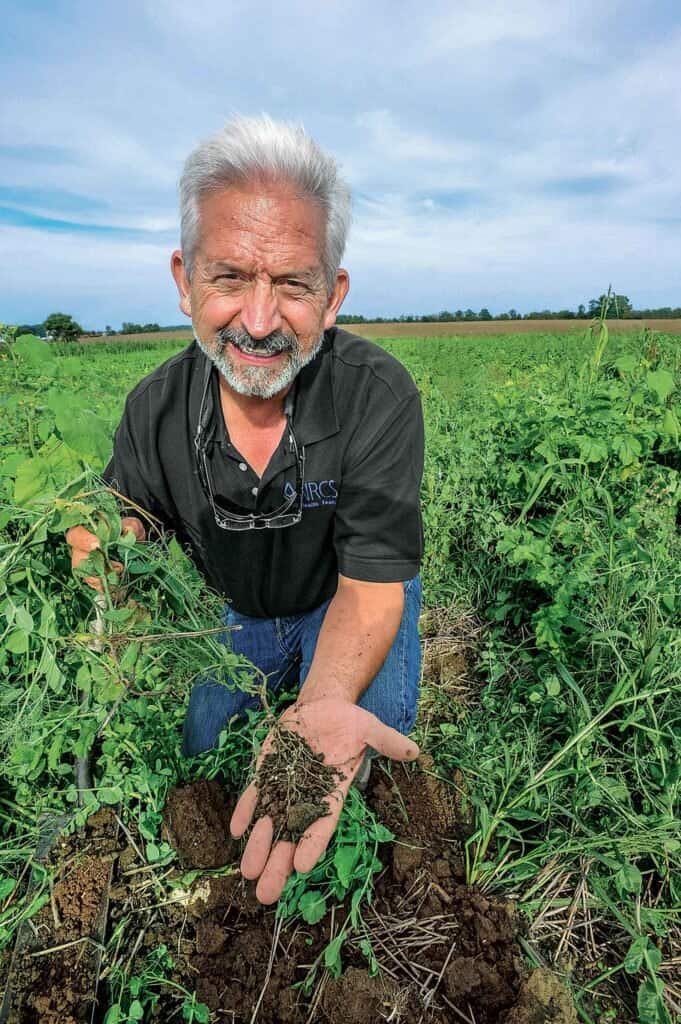 | After working across multiple states as a soil conservationist and water quality specialist, he retired from USDA to co-found Understanding Ag and the Soil Health Academy, where he teaches farmers how to build living, thriving soils through cover crops and biomimicry strategies. His passionate, hands-on demonstrations—showing farmers how healthy vs. degraded soils respond to water—have been credited with driving much of the cover crops movement we see today. |
As a co-founder of Understanding Ag alongside Gabe Brown and others, he's helped the consulting firm grow from zero to over 34 million acres under regenerative management, earning him recognition as someone who "tells it like it is" and has fundamentally shifted how thousands of farmers think about soil health and profitability.
Read more about Ray Archuleta…
THAT’S A WRAP!
Before you go: Here are 3 ways I can help…
Hire me to write for you — Studies show customers are willing to pay up to 64% more for products with stories that resonate with their values and interests.
The Runamuk Blog — Follow my farm’s story and gain real-world insight into the ups and downs of eco-farming. Receive essays and articles direct to your inbox.
How to Buy a Farm With NO Money — If you’re a landless farmer in the U.S. seeking a farm of your very own, my book will guide you through the loan process with the USDA.
See you next week!
—Sam
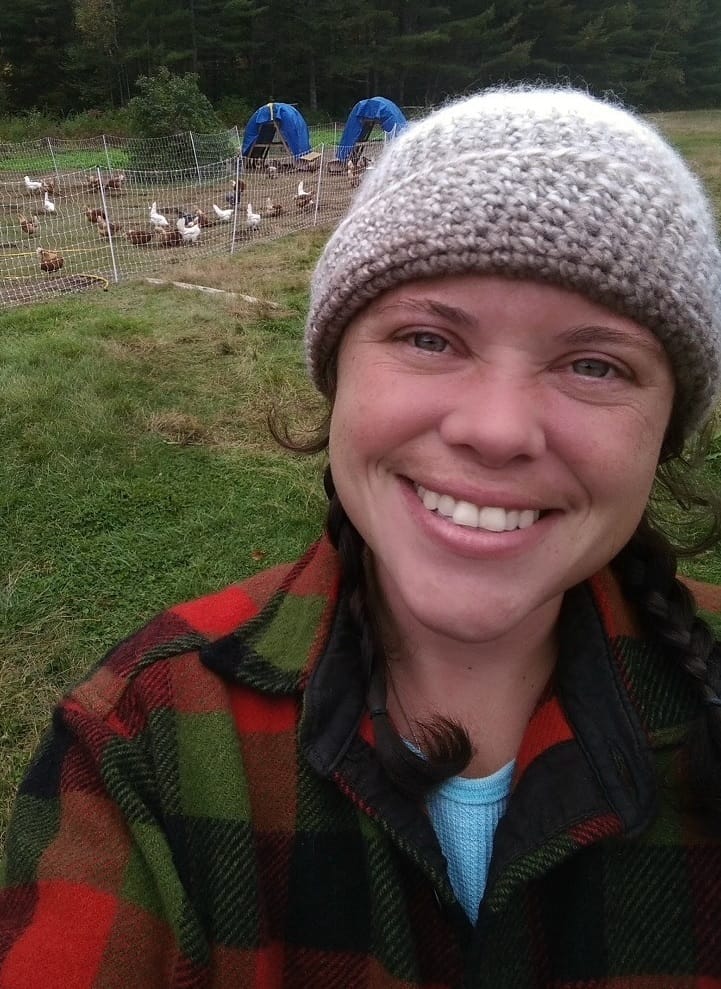
PS - Check out my most recent farm-update! Click Here
Feel free to send me feedback: [email protected]